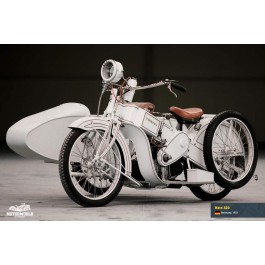Browse By
|
1921 Mars A20DescriptionThe oldest motorcycle shown in Motorworld museum is the magnificent German Mars A20 of 1921, which is nicknamed "White Mars". First released in 1920, the Mars A20 motorcycle (also called Reisemaschine, i.e. a ‘vehicle for traveling’) was a focus of the latest original technical ideas of the time. First of all, it didn’t have a frame in the common sense of the word.Under the truss was a lower-valve, two-cylinder, 956 cubic inch, 7.3 horsepower engine with an external flywheel, which also acted as a forced-air cooling fan. The engine and box truss formed a single power structure, which also included the crankcase of two-stage gearbox. The transmission deserves special attention: there were two drums with internal friction pads on a transverse shaft. From each drum to the rear wheel ran its own chain, so there were two sprockets at the rear. When a gear was selected, one of the drums was braked and torque was transmitted to the rear wheel. On top of the drive drums were belt brakes, one manually operated and the other foot operated. The engine was started like an automobile engine - with a rotating crank through a special actuator (so-called "curve"). Since the wheel hubs had no brake mechanisms, the wheels were interchangeable with each other. Detailed Information
Additional InformationAdditional Information
|



